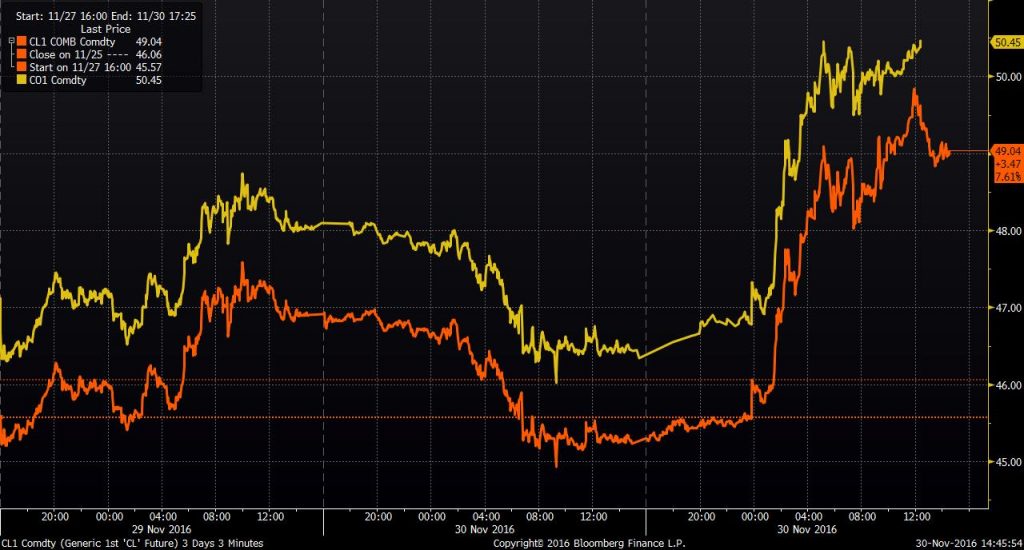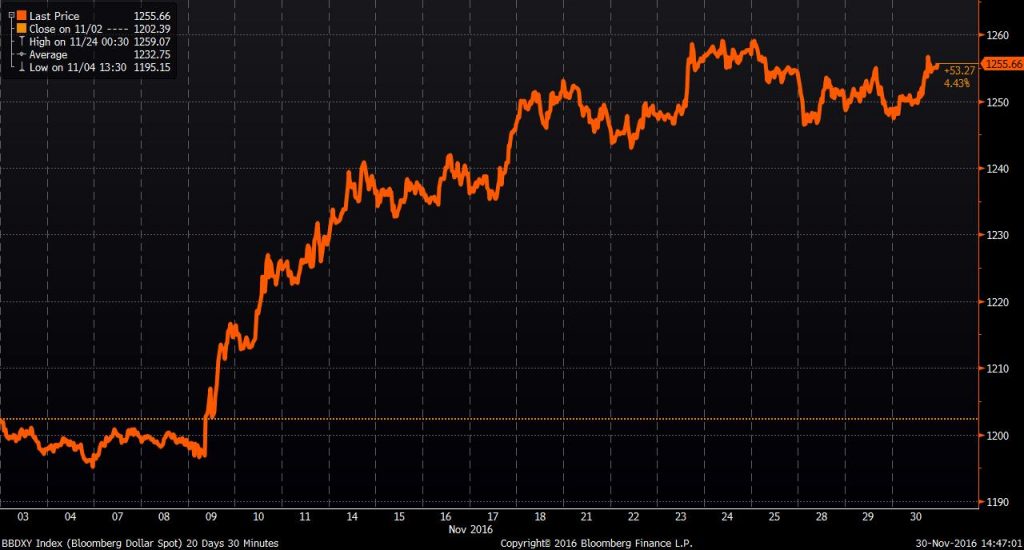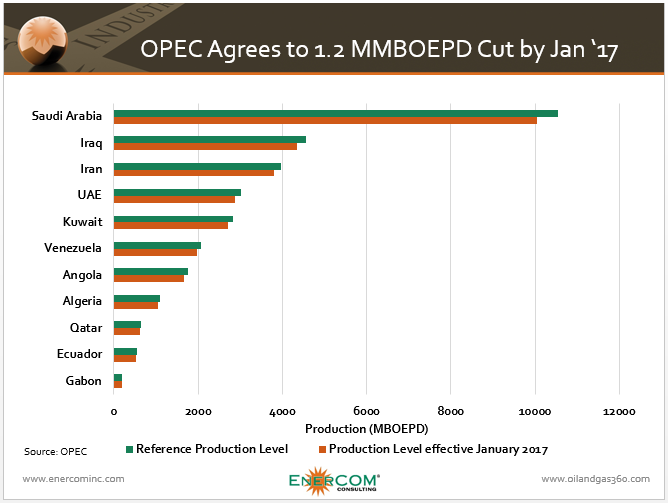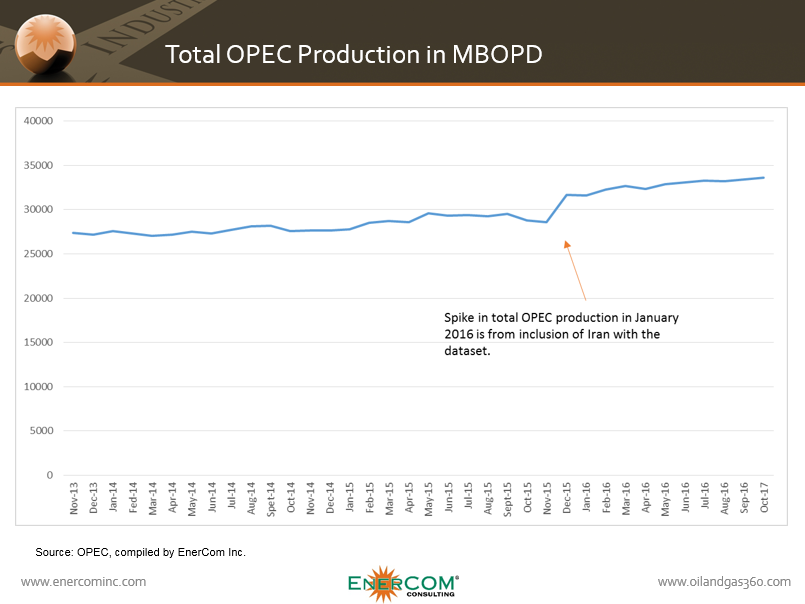OPEC Agrees to a 1.2 MMBOPD Cut
“We have made great success today” – OPEC announces first cut since 2008
“We have made great success today. We reviewed all scenarios… [and] we have been able to reach an agreement,” Qatar energy minister and president of the OPEC Conference, Mohammed Bin Saleh Al-Sada said in the introduction to a press conference announcing a production cut by the Organization of Petroleum Exporting Countries.
“Today OPEC agreed in its scenario. But also OPEC has been in contact with key non-OPEC countries to participate in this agreement,” Al-Sada said.
In summary OPEC will reduce approximately 1.2 MMBOPD to 32.5 MMBOPD effective 1 January 2017.
“We agreed to share that reduction among OPEC countries. We took into consideration that some countries need special consideration. We did that unanimously,” Al-Sada said.
He said Indonesia would like to freeze or suspend their membership. “They are not withdrawing, they are suspending their membership. They think they will face difficulty in participating in the unanimous agreement in the OPEC decision.”
“This agreement includes a 600 MBOPD cut from non-OPEC countries. The Russian Federation agreed to reduce 300 MBOPD. Other countries have as well. There will be another similar press conference in Moscow to address this OPEC move to get the market rebalanced, the catalytic effect to rebalance the market.
“This is basically the summary of the agreement of today. This is a major step forward and we think that it is a historic moment to come to this agreement to rebalance the market and reduce the stock overhang.”
After the opening comments by Al-Sada, the meeting was opened to questions.
Reuters: Did the election of Donald Trump and [his stance on] the Iran agreement come up in discussions in the last few days?
OPEC: We are considering supply and demand and the stock overhang, but we don’t speculate fully on what would be the policies of the U.S.A. We take in the interest of consumers and of producers as well as the economy. We believe a fair price will benefit all. It will definitely move the economy above the 2% level.
Bloomberg: What is the new floor for production now that Indonesia has withdrawn? Is it 32.5 or is it a different number. I wanted to know if looking at it two years later, was that policy decision OPEC made in November 2014 a mistake.
OPEC: I wouldn’t classify it as a policy; it was a reaction to market circumstances in the best wisdom of OPEC and analysis from OPEC and external think tanks. We did discuss what is best. It never came to our mind that we are regretting what we did. We think what we did in OPEC has also advantages that production of oil and gas became in a more rational manner, more rational expenditure. A lot of high cost producers became more rational in their production. And it’s 32.5 MMBOD.
Q: How do you explain the floor still at 32.5 after Indonesia withdrawing, and is the non-OPEC binding or non binding?
OPEC: The news will be from Russia. Today and over the last few weeks we had intensive communications. Many countries are prepared to cut. Russia will take 300 MBOPD out of production. Russia is in support of our position. They said they would freeze originally, but they said they are willing to do more than that. We are open minded about other venues for the next meeting.
OPEC: Initially was requested to reduce by a certain amount. That amount has been distributed among the other countries.
THE ECONOMIST: You said the cut of 1.2 MMBOPD was subject to the 600 MBOPD by non-OPEC. If the non-OPEC won’t stay to that, does your agreement hold. What cut did Saudi Arabia agree to?
OPEC: The cut of 1.2 and the 600—we believe it is very much achievable. There will be a table distributed to you and I believe Saudi Arabia will cut around 486 MBOPD.
Q: Will the numbers on the table be described as allocations, quotas or temporary limits or other?
OPEC: We called them “adjustments” for the coming six months. We will come back and review it. We allowed in the agreement for a rollover of six more months. A committee consisting of five countries and the Secretary of OPEC will continuously monitor and submit a report. On May 25th we will meet again and that meeting is mainly meant to review the monitoring committee report. The intention is to extend it for six more months.
AMERICAN UNIVERSITY: Mr. Chairman, some analysts think that when oil production declines, there will be an increase in price that will benefit not OPEC but shale producers.
OPEC: The idea is to take measures to get the market rebalanced. We are not saying the rebalance will be from just OPEC and non-OPEC key members, but producers from outside will react to the price, but we cannot see a threat from shale gas and shale oil producers, because they will look at how much it will cost them, and the affordability. They will do it without us interfering. We think this measure will help rebalance. There will be effects on expensive producers, not only shale oil, but others.
CNN: You tried for agreements in April and in September. For the naysayers that said OPEC couldn’t deliver a deal what do you say and can the non-OPEC deliver the 600 MBOPD?
OPEC: We can get 300 from Russia and the others will announce it themselves. They showed commitment and we are assured we will get the 600, maybe more.
CNN: Many were concerned if OPEC was still relevant.
OPEC: I think without the OPEC presence and efforts to get momentum between OPEC and non-OPEC, such a responsibility; the amount of cooperation with non-OPEC countries made them like part of OPEC and what counts is movement. OPEC gathered the momentum and took the biggest share; that means the weight of OPEC and the resilience of OPEC is still there.
The press conference ended there. The OPEC agreement is available for download here.
Before the official announcement by OPEC, oil took off in early trading, rising 8%, based on reports that OPEC will announce a production cut to an output ceiling of 32.5 MMBOPD and Russia and other non-OPEC producers would contribute a cut of another 0.6 MMBOPD.

OPEC Agrees to a 1.2 MMBOPD Cut – prices of crude oil shot up in morning trading before the Nov. 28 OPEC announcement.
Saudi Arabia and regional rival Iran appear to have come to an agreement over production after the latter resisted cuts to production following the end of international sanctions. in advance of today’s press conference, a source inside the OPEC meeting told media that the group decided to suspend Indonesia from OPEC and allow Iran to set new production levels at 3.797 MMBOPD. Iran’s production was 3.69 MMBOPD in October, according to secondary sources.
Indonesia rejoined OPEC in June of 2015 despite being a net importer of crude oil.
OPEC Reaches a Production Deal and Brent Hits $50, Now What?
OPEC deal to cut 1.2 MMBOPD could return market to balance in the first half of 2017
Crude oil prices surged Wednesday following news from OPEC that the group agreed to cut 1.2 MMBOPD of production after two years of producing near capacity in a bid for market share. OPEC agreed to cap production at 32.5 MMBOPD, which, along with agreements form non-OPEC members to reduce production by 600 MBOPD, should reduce global output by 1%.
Market watchers were uncertain which way the meeting would go after months of negotiations between OPEC members about how much to cut, and where. Much of the tension surrounded regional rivals Saudi Arabia and Iran – the organization’s first and third largest producers, respectively. Talks to freeze production had been sunk before by disagreements between the two, and many worried that Iran’s insistence to return its production to pre-sanction levels would prevent today’s deal as well.
Today’s deal signifies a turning point for OPEC, however, with Saudi Arabia agreeing to Iran maintaining its current production while the kingdom and other members of OPEC make production cuts. As part of the deal, Indonesia has suspended its membership in OPEC, allowing Iran to set its production cap at 3.797 MMBOPD almost 3% higher than the 3.69 MMBOPD it produced in October.
“Before, we were thinking that, optimistically, we could reach market balance at the back-half of 2017 or the front-half of 2018,” Wunderlich Director of Equity Research and Chief Market Strategist Art Hogan told Oil & Gas 360® today. “Now I think we can get there in the front-half of 2017.”

Danger remains, but likely not from OPEC
One of the major concerns following today’s deal is whether or not OPEC members will actually comply with the deal reached in Vienna. The group has a poor record of upholding production cuts, with Saudi Arabia often shouldering the majority of the burden. Given that OPEC has continually increased production over the last two years and is now likely producing near capacity, the group has little room to cheat, said Hogan.
“Saudi Arabia will probably shoulder the bulk of the burden, but the rest of OPEC will be producing at levels similar to where they are now, except for maybe Iraq,” he explained. “But if there’s cheating, I suspect that it’s going to come from a non-OPEC countries that say they’re complying and are just along for the ride.”
As part of today’s deal, it was announced that Russia plans to cut its own production by 300 MBOPD, while other non-OPEC producers will reduce their output by a collective 300 MBOPD, and possibly more. Whether or not Russia and other non-OPEC producers will follow through on this promise remains to be seen, however.
“The risk here, in my mind, is not non-compliance, but how strong the dollar gets,” said Hogan. As the dollar increases in value compared to other currencies, it becomes more expensive for buyers to purchase dollar-denominated commodities like crude oil.
“The dollar will probably strengthen in 2017, but not at the same rate that we’ve seen in the last three weeks. The recent strength is a knee-jerk reaction to a Fed that is clearly going to be tightening,” Hogan added, saying that the currency markets usually do a good job of self-correcting.

For Saudi Arabia and OPEC, deal was a must
With regional rivals able to compromise, it appears that relations between Saudi Arabia and Iran might be improving, but today’s deal was reached out of necessity, former Ambassador to Oman and CEO of Equilibrium International Consulting Gary Grappo told Oil & Gas 360®.
“This was a very decisive moment for OPEC. If they had been unable to reach this agreement, they would have lost all credibility with the international economic community,” said Grappo. “Not only would the lack of a deal reflect poorly on OPEC, but also on Saudi Arabia, which is seen as a major player in the international economic community in part because of its influence in the group.
“The agreement was clearly in the interest of both Saudi Arabia and Iran. Iran wanted to preserve the ability to resume production at pre-sanction levels. They settled for a bit less,” but increased prices will help both countries.
Saudi Arabia and Iran will likely remain divided on other key issues like the wars in Yemen and Syria, with today’s agreement coming down to business rather than improved political relations, according to the ambassador.
“My suspicion is that Saudi Arabia may have been ramping up production ahead of this, knowing they would have to take the biggest cut. They are facing significant budget pressure, and they are looking for ways to minimize that now.”
Improved oil prices will also help the kingdom with the pending IPO of a portion of state-owned Saudi Aramco. With improved oil prices, Aramco will appear as a more attractive investment opportunity, meaning more capital for the kingdom to move forward with its plans to diversify its economy.
“I suspect the driver behind this was Deputy Crown Prince Mohammed bin Salmon. They needed Aramco to look attractive to execute Vision 2030,” said Grappo.
So where will oil prices go in 2017?
On Nov. 27, Wells Fargo issued a research report discussing possible outcomes in advance of the Nov. 30 OPEC meeting. Their general oil price summary follows:
“For 2017, we remain comfortable that oil prices will continue to slowly recover towards a near-term equilibrium of $55-60/bbl by H2 2017. Providing confidence for this outlook is the recent trends in global inventory data which indicates modest declines in OECD crude oil and product inventories since mid-2016. It is also important to note in our view that our supply/demand model implies that inventories should have grown by approximately 180 mmbbls yet actual inventory growth is less than one-third that volume. The clear takeaway – the global oil market is a bit tighter than anticipated year-to-date in 2016. Higher demand, lower supply or some combination of the two is the simple and straightforward explanation. Regardless of the how, we believe this is a situation likely to persist into 2017.
“As a result, our oil price deck is approximately $3-4/bbl above consensus in 2017 with the majority of the separation occurring in H2 2017. That said we are nowhere near the optimistic crowd which foresees oil rising well above $70/bbl for an annual average. In our view, there is simply too much oil available for development and far too much in easy access storage for oil to sustain above $70/bbl for a full year. Also, we are skeptical that demand growth would be immune to a near doubling of oil prices from the 2015/2016 averages.”
You Can Thank Putin for OPEC’s Cut
Russian President Vladimir Putin’s key role in brokering the OPEC agreement
The price of crude oil continues to climb past $50 per barrel following OPEC’s deal to cut 1.2 MMBOPD of production Wednesday.
A number of non-OPEC producers will join the organization in lowering output, chiefly Russia, which has agreed to reduce its production 300 MBOPD from post-Soviet highs. Russian President Vladimir Putin appears to have played a key role both in Russia’s involvement in production cuts, and the success of the OPEC deal, which many feared would fall apart as regional rivals Saudi Arabia and Iran continued to butt heads.
Many market watchers were concerned that the deal may not materialize as Saudi Arabia continued to demand that Iran join in making production cuts, despite the Islamic Republic’s repeated instance on increasing production to pre-sanctions levels. In a compromise that took some by surprise, Saudi Arabia will take “a big hit” and cut its production by 486 MBOPD while Iran will increase its own slightly by 90 MBOPD.
Former Ambassador to Oman and CEO of Equilibrium International Consulting Gary Grappo told Oil & Gas 360® Saudi Arabia needed the political win, and both countries will benefit from higher prices, but it appears Putin also played a key role in Wednesday’s outcome.
Pivotal intermediary
Putin acted as a pivotal intermediary between Riyadh and Tehran, according to a report from Reuters. Ahead of Wednesday’s deal in Vienna, the Russian president established that the Saudis would shoulder the majority of OPEC’s cuts, as long as Iran agreed not frame the compromise as a victory over the kingdom. Putin discussed the agreement with Iranian President Rouhani who, along with Iranian Oil Minister Bijan Zanganeh, convinced Ayatollah Khamenei of the importance of accepting the deal and continuing political lobbying with Putin, reports Reuters.
Zanganeh kept a low profile at the meeting in Vienna, according to OPEC delegates. Afterwards, the normally combative minister avoided any comment that might be read as claiming victory over Riyadh.
“We were firm,” he told state television. “The call between Rouhani and Putin played a major role … After the call, Russia backed the cut.”
Now Putin’s authority faces a test in his own country
While many are relived with the outcome of this week’s OPEC meeting, it remains unclear how exactly Russia will cut 300 MBOPD of its own production. Following the OPEC announcement, Russian Energy Minister Alexander Novak said the country would “gradually” cut production in the first half of 2017.
“Russia is ready to join the agreement … Based on our active talks over the last couple of months with key OPEC members and non-OPEC countries, Russia will gradually cut its output by up to 300,000 barrels per day in the first half of 2017,” Novak told reporters.
He added that it was technologically challenging for Russia to cut production sharply.
“Our talks with non-OPEC countries allow us to expect some countries to join the deal, cumulatively contributing approximately up to 300,000 bpd,” Novak said. He did not elaborate.
So far, no Russian oil companies have explained how they will cut production, and “even if mandated by the Kremlin, [a production cut] would be akin to herding cats,” Macro Advisory Moscow Partner Chris Weafer told Bloomberg. Lukoil, Russia’s second-largest producer, supports OPEC’s moves to stabilize global oil markets, Pavel Zhdanov, the company’s director of capital markets and mergers and acquisitions, said during a conference call. It appears that majority of Russia’s cuts will fall on state-owned Rosneft, however.
“Rosneft looks like the number one company that should take the biggest share of the cut,” Ildar Davletshin, an oil analyst at Renaissance Capital, said by e-mail. It controls almost 50 percent of Russian oil output and it has one of the lowest shares of so-called greenfields, or new developments, in its production portfolio, he said.
Russia’s cuts are its decline curves
Cuts will likely be centered on aging and less economic fields, with companies like Rosneft allowing decline curves to take care of cuts for them, rather than halting the development of new projects. Moving forward with more greenfield projects allows Russia to protect its service industry as well, according to Mikhail Pshenitsyn, who has worked for more than 10 years in the country’s oil industry.
“The average production at new wells in Russia is around 50 tons a day, so Russia would need to decide against drilling around 800 new wells and leave some 100 drilling teams out of work,” Pshenitsyn said. “And where will we get them once we need them again?”
Cuts to Russian production, and the share of that burden that would likely fall to Rosneft, could put Putin at odds with his long-time ally, and CEO of the state-run oil giant, Igor Sechin. Leading up to the November 30 meeting, Sechin made no secret of the fact that he did not believe Rosneft should freeze production, much less reduce output.
Why should we do it?
“Why should we do it?” Sechin, known for his anti-OPEC position, said to Reuters in October. Sechin followed up with another question, asking if Iran, Saudi Arabia or Venezuela would cut their own production, implying the answer was likely “no.” Now that Saudi Arabia and Venezuela, which has been suffering more than most OPEC members, have both agreed to cuts, it remains to be seen if the head of Rosneft will fall in line with Putin’s plan.
“Putin wants the deal. Full stop. Russian companies will have to cut production,” a Russian energy source briefed on the discussions said to Reuters.
Venezuela needs higher oil prices, Putin got them
 Stratfor reported today that the Venezuelan government expects social unrest to increase in 2017. “The country has prioritized making its foreign debt payments over using its oil revenue for imports,” according to Stratfor, “which has led the food supply to continue to tighten and inflation to climb. Control of food through a network of distribution networks, known as Local Supply and Production Committees, directly administered by the Venezuelan state under the direction of the Defense Ministry, could help the government keep a lid on security disruptions driven by worsening economic conditions. Widespread protests against the government may be less likely if people fear that those actions could disrupt their food supply, given that the state directly administers most of these networks,” according to the report.
Stratfor reported today that the Venezuelan government expects social unrest to increase in 2017. “The country has prioritized making its foreign debt payments over using its oil revenue for imports,” according to Stratfor, “which has led the food supply to continue to tighten and inflation to climb. Control of food through a network of distribution networks, known as Local Supply and Production Committees, directly administered by the Venezuelan state under the direction of the Defense Ministry, could help the government keep a lid on security disruptions driven by worsening economic conditions. Widespread protests against the government may be less likely if people fear that those actions could disrupt their food supply, given that the state directly administers most of these networks,” according to the report.
“The country is betting that the OPEC production cut finalized Nov. 30 will lead to sustained higher oil prices. If that is the case, Venezuela could have a greater ability to mitigate the potential for unrest and to avert a more disastrous outcome, such as a foreign debt default for state oil and natural gas company Petroleos de Venezuela.” PDVSA missed an interest payment in November.
Venezuela President Nicolas Maduro heaped praise on Putin at the sidelines of Fidel Castro’s funeral, according to Russian news agency TASS in a story published Tuesday. “Putin’s victories are our victories,” Maduro said, “We’re all looking towards Putin. For us, he is an emblem of fighting for independence and multipolar world.”














